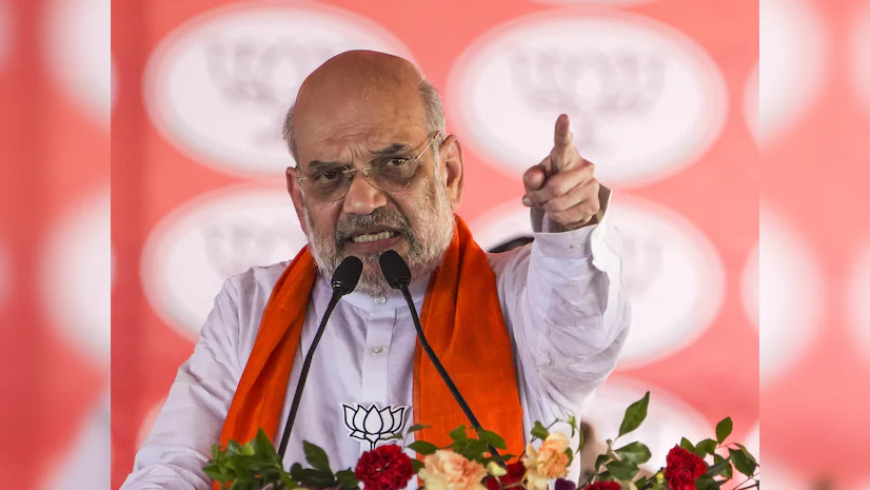Amit Shah Sets Bold Target: BJP Eyes Power in Tamil Nadu and Bengal by 2026
Union Home Minister Amit Shah predicts BJP’s rise in Tamil Nadu and West Bengal in the 2026 Assembly polls, outlining aggressive strategy and regional outreach. Full analysis with verified political insights.

In a politically charged declaration that may redefine regional dynamics, Union Home Minister Amit Shah has confidently stated that the Bharatiya Janata Party (BJP) will come to power in Tamil Nadu and West Bengal in the 2026 Assembly elections. His remarks came during high-energy public addresses in Chennai and Kolkata, where he unveiled the party’s strategy to penetrate traditionally non-BJP states with focused campaigning, organizational revamp, and youth mobilization.
The statement has sent ripples through both regional parties and political analysts, who are watching closely to see if BJP can translate its growing vote shares into actual electoral wins in two of the most culturally distinct and politically complex states in India.
BJP’s Tamil Nadu Ambitions: Taking on the Dravidian Stronghold
Addressing a massive gathering in Chennai, Amit Shah criticized the DMK government’s performance, particularly on corruption, law and order, and economic stagnation. He appealed directly to the youth and women, asserting that the “time has come for Tamil Nadu to see a double-engine government.”
While BJP has never been a major player in Tamil Nadu, the party has steadily increased its presence through alliances, social media engagement, and outreach programs like the En Mann En Makkal yatra led by state BJP chief K. Annamalai.
Political observers cite BJP’s focus on corruption issues, Hindu identity politics, and the failure of opposition unity as key levers in its 2026 game plan.
According to a Times of India report, party insiders are also working on a booth-level reorganization and tapping into dissatisfaction with the current government’s handling of law and order.
Bengal Battle 2026: Reigniting the 2021 Spark
In West Bengal, Amit Shah’s assertion that BJP will “sweep to power in 2026” is a renewal of the party’s ambitions following its impressive 77-seat gain in the 2021 Assembly elections, although it fell short of dislodging Mamata Banerjee’s Trinamool Congress (TMC).
Shah’s address in Kolkata was laced with sharp criticism of the TMC, alleging rampant corruption, political violence, and appeasement politics. He vowed justice for BJP workers and accused the ruling party of misgovernance and intimidation.
“The countdown has begun for TMC. Bengal has seen the truth. In 2026, BJP will form the government with a full majority,” Shah declared, as reported by The Indian Express.
The BJP is recalibrating its Bengal strategy by emphasizing grassroots mobilization, youth outreach, and targeting constituencies where it narrowly lost in 2021. Sources within the party suggest a significant focus on tribal belts and border districts, where national security and cultural issues resonate strongly.
The Roadmap: Grassroots Strengthening and Regional Messaging
Shah stressed that BJP’s victories in 2026 would be rooted in booth-level strength, citing the importance of a micro-targeted voter strategy. In both states, the BJP is reportedly working with advanced data analytics, local influencers, and regional language content to increase its cultural relatability — a previous shortcoming in these linguistically proud states.
In Tamil Nadu, efforts to promote native leaders like Annamalai while maintaining a respectful stance toward regional pride are seen as part of a smarter, more adaptive approach. Meanwhile, in Bengal, Shah emphasized the importance of law and order and “restoring the rule of law” — a theme that plays well among middle-class and urban voters.
Political experts at Observer Research Foundation (ORF) have analyzed the BJP's South India roadmap, highlighting how the party is balancing cultural nationalism with economic promises in the region.
Opposition Reactions: DMK and TMC Push Back
Both the DMK in Tamil Nadu and the TMC in Bengal have dismissed Shah’s predictions as “rhetoric aimed at diverting attention” from national issues such as unemployment, inflation, and governance failures.
DMK MP Kanimozhi stated that “Tamil Nadu will never accept Hindutva politics,” reaffirming the party’s position on secularism and federalism. Meanwhile, TMC spokesperson Derek O'Brien labeled Shah's Bengal visit a “photo-op tour” and claimed that BJP’s base was shrinking post-2021.
However, BJP supporters argue that both states are showing signs of fatigue with current regimes and that voters are increasingly receptive to change, particularly among urban youth and first-time voters.
The Bigger Picture: BJP’s Pan-India Blueprint
Shah’s announcements are not isolated political jabs but reflect the BJP’s broader pan-India electoral blueprint, which aims to consolidate existing strongholds while expanding into uncharted territories before 2029. The party’s recent push in Kerala, Telangana, and Odisha underscores a new confidence in challenging entrenched regional parties with aggressive outreach and narrative-building.
According to India Today’s recent analysis, the BJP is investing heavily in local language media, IT cells, and state-level leadership grooming — a long-term strategy that may slowly pay dividends.
Conclusion: A High-Stakes Gamble or Strategic Masterstroke?
Amit Shah’s 2026 prediction is a high-stakes political bet that underscores the BJP’s ambition to evolve from a party with regional gaps to a truly national force. Whether the party succeeds in these southern and eastern frontiers will depend not just on rhetoric, but on sustained groundwork, adaptability, and resonance with local aspirations.
As the countdown to the 2026 Assembly elections begins, the political chessboard of India looks poised for another dramatic shift — with Tamil Nadu and Bengal emerging as key battlegrounds in BJP's long-term mission.














